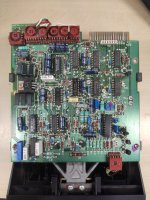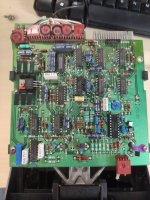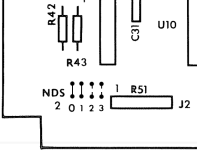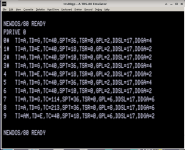Ultraman
New Member
I have an issue I hope somebody here might either recognize and/or can help diagnose. 
This story is about a Tandy TRS-80 Model 3, 48K RAM and two floppy drives.
It is not mine, but I was asked to have a go at this one at the museum I volunteer at.
My experience with TRS-80s was non-existent at the time, and it still is minimal at the moment.
I would really like to restore this machine to full function, and I am getting close but a floppy drive issue has eluded me so far.
A colleague worked on the system before my and concluded the disk controller might have been faulty.
So a replacement disk controller was ordered from The Right Stuff (www.frehd.com).
This is where I came along and was asked: "Please replace the disk controller for this machine and figure out how to write disks for it. Have fun!"
And I did have fun and got work done on this machine in the process.
I'll skip the figuring out how to write disk part and skip ahead to: I replaced the original disk controller with the Repro FDC, and connected it to the system board with the shiny new flat cable.
This TRS-80 Model III is now in a decent state:
It starts without issue into the BASIC ROM and I can also boot into NEWDOS/80 2.0 from floppy in drive 0 and run programs.
Where it goes wrong is when you try to do anything with drive 1.
I can put a known good floppy, that works in drive 0, into drive 1 and try to access it. The floppy drive will activate, you hear the head seek and move multiple times, fairly short passes, until the machine informs you it ran into an error after a short while.
So I have a working drive 0. Can boot from it, I can read from it, can possible write (I must admit I haven't tried that yet). Drive 0 seems to work fine.
Drive 1 simply doesn't.
(If helpful I could try make a video of the behavior of floppy drive 1 coming Friday, let me know?)
The floppy drives are full height drives. IIRC they are the Texas Peripheral Incorporated variant.
Fairly simple in construction. I could not make out any jumpers or programmable shunts to configure them. Seem to be the original drives for the system.
I know Disk Select is done with the cable in the TRS-80 M3 via missing pins in the connectors. And the cable used is indeed missing pins for those signals.
One of the drives had a broken clip in the hinge mechanism. The two prongs holding onto the brass bar were broken. I replaced that part and the drive closes properly again.
Here's the list, from the top of my head, what I have tried to figure out what might be wrong and resolve the issue:
After installing the old controller drive 1 performed exactly the same. Drive spun up, head seeked the same and failed with an error after a short while.
So the old controller is exhibiting the exact same behavior as the replacement Repro FDC. Hmm...
What I want/am going to try next:
Hopefully any of you have a good idea on how to proceed.
In the mean time I am going to try and look for information here and read further(technical) manuals I can find.
This story is about a Tandy TRS-80 Model 3, 48K RAM and two floppy drives.
It is not mine, but I was asked to have a go at this one at the museum I volunteer at.
My experience with TRS-80s was non-existent at the time, and it still is minimal at the moment.
I would really like to restore this machine to full function, and I am getting close but a floppy drive issue has eluded me so far.
A colleague worked on the system before my and concluded the disk controller might have been faulty.
So a replacement disk controller was ordered from The Right Stuff (www.frehd.com).
This is where I came along and was asked: "Please replace the disk controller for this machine and figure out how to write disks for it. Have fun!"
And I did have fun and got work done on this machine in the process.
I'll skip the figuring out how to write disk part and skip ahead to: I replaced the original disk controller with the Repro FDC, and connected it to the system board with the shiny new flat cable.
This TRS-80 Model III is now in a decent state:
It starts without issue into the BASIC ROM and I can also boot into NEWDOS/80 2.0 from floppy in drive 0 and run programs.
Where it goes wrong is when you try to do anything with drive 1.
I can put a known good floppy, that works in drive 0, into drive 1 and try to access it. The floppy drive will activate, you hear the head seek and move multiple times, fairly short passes, until the machine informs you it ran into an error after a short while.
So I have a working drive 0. Can boot from it, I can read from it, can possible write (I must admit I haven't tried that yet). Drive 0 seems to work fine.
Drive 1 simply doesn't.
(If helpful I could try make a video of the behavior of floppy drive 1 coming Friday, let me know?)
The floppy drives are full height drives. IIRC they are the Texas Peripheral Incorporated variant.
Fairly simple in construction. I could not make out any jumpers or programmable shunts to configure them. Seem to be the original drives for the system.
I know Disk Select is done with the cable in the TRS-80 M3 via missing pins in the connectors. And the cable used is indeed missing pins for those signals.
One of the drives had a broken clip in the hinge mechanism. The two prongs holding onto the brass bar were broken. I replaced that part and the drive closes properly again.
Here's the list, from the top of my head, what I have tried to figure out what might be wrong and resolve the issue:
- First I cleaned an lubricated both floppy drives. No change.
- I swapped floppy drive A to position 1 and floppy drive B to position 0.
After doing this the other, previously non-functional, drive B would work just fine as drive 0 and was able to boot a NEWDOS/80 2.0 right up.
While drive A, now drive 1, would display the same symptoms.
Both drives seem good. Because when swapped, they work as drive 0. - Checked for jumpers, termination and/or shunts to configure drive options. Could not really find any.
Learned Drive Select is performed by leaving out a few pins in the connector. Smart.
Concluded: both floppy drives are OK. Either works as drive 0.
And I don't see jumpers nor termination (which I read is normal for TRS-80 M3). (picture of both floppy drive logic boards below)


- Cleaned all contact pads of the edge connector on the drives and best I could of the cable.
They didn't look too bad to begin with. Some dirt came off but nothing remarkable. - Made a new floppy cable. I took out the same pins as the original connector, double checked they were the correct ones according to the pinout specification and measured contact of each pin using a multimeter to be extra sure.
No change: issue isn't with the floppy cable. - Tried another known good (360K) floppy drive in position of drive 1, jumpers set accordingly (iirc DS2 (from [1-4], no termination, didn't touch MX (believe it was open)).
Just to see what would happen. Was not able to read a disk that either. Didn't fully expect that to work, but had to try. - Measured resistance of pins from the motherboard to the disk controller card: a fiddly job, but all measured OK.
- Ensured all earth connections are connected and secure.
Did not test their continuity. But all seems snug, clean enough and OK.
- settings? Did I miss a jumper on one of the drives that is simply misconfigured?
- something on the brand new disk controller?
- I have been using the sameNEWDOS/80 2.0 boot disk for my testing of drive 1. Could it contain some setting that would throw off drive 1?
After installing the old controller drive 1 performed exactly the same. Drive spun up, head seeked the same and failed with an error after a short while.
So the old controller is exhibiting the exact same behavior as the replacement Repro FDC. Hmm...
What I want/am going to try next:
- boot from a different floppy, perhaps a different version of NEWDOS/80. To exclude the software side of things more.
- try to access drive 1 from the BASIC ROM. I found https://forum.vcfed.org/index.php?threads/trs-80-model-3-disk-drive-issues.1239489/ recently and some other threads that discuss this. See what happens and how it behaves.
- attempt to run diagnostic software.
First I want to test the RAM, because I have replaced several 4116 DRAM chips after experiencing corrupting characters on the display. Ran all the DRAM through the Retro Chip Tester and it pointed out several had errors.
Afterwards I want to try something that could test the disk controller and floppy drives. - anything you suggest I try?
Hopefully any of you have a good idea on how to proceed.
In the mean time I am going to try and look for information here and read further(technical) manuals I can find.
Last edited:


